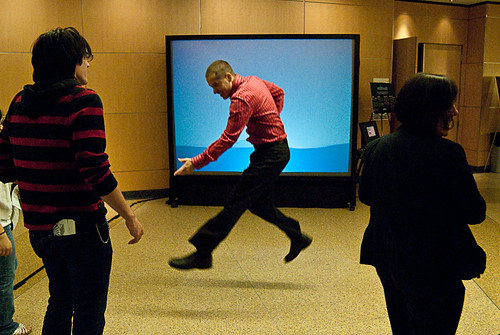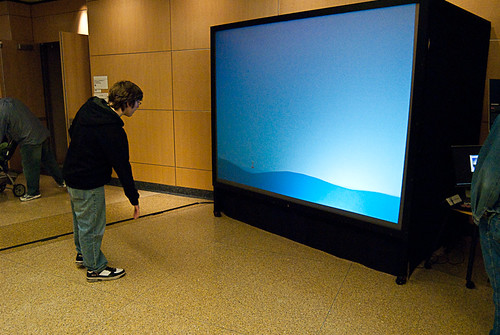Waterwall
Waterwall is a project that explores technology's place in public spaces, particularly as a tool for fostering new kinds of interactions. It's an interactive art installation where the body's motion and presence are the main input mechanism.
Concept
Inspired by work from interactive artists Camille Utterback, Scott Snibbe and Jonathan Harris, colleague Tony Dewan and I designed an interactive art installation to inspire people to publicly behave in untraditional ways and interact with others they normally wouldn't.

1 Participants interact with Waterwall, pushing the buoy by creating waves.

2 Jumping forms a more powerful reactionary wave.

3 Fewer people in the interaction space lowers the waterline.
Aesthetically, Waterwall is simple. The waterline is controlled by two forms of user behavior within the 12-square-feet interactive space: movement injects waves in the water and presence increases the water's fill height. A buoy floats along this waterline, reacting in context. The buoy beckons users to play; tells jokes if bored; and complains about sea sickness if the water is violent. In essence, a cross-medium, low barrier-to-entry dialog is formed between users and the buoy, communicated through movement and textual response.
Waterwall is built upon one hardware and two software layers. All input derives from a video feed mounted on the ceiling pointed toward the floor. The video processes real-time in an ActionScript 3 AIR application; and forwards the appropriate wave and fill events to the water visualization.
On Friday, May 1, 2009, Waterwall premiered in the lobby of the IUPUI IT Building. We noticed individuals joyfully experimenting with the interaction, with props and in groups1, with dancing2 and in fascination.3 For that evening, Waterwall deconstructed social barriers and the buoy made new friends.